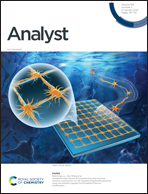Engineering a lipid droplet targeting fluorescent probe with a large Stokes shift through ester substituent rotation for in vivo tumor imaging†
Abstract
Great progress has been made with lipid droplet targeting fluorescent probes in a wide range of biomedical fields. However, the Stokes shifts of most fluorescent probes are relatively small, leading to strong biological background fluorescence, poor signal-to-noise ratios, self-quenching in the commonly used microscopes and the need for in vivo imaging systems. In this manuscript, the ester substituent rotation of fluorophores was supposed to result in a large Stokes shift via steric hindrance effects and resonance effects. A lipid droplet targeting fluorescent probe 1 was achieved by simply appending a 4-substituted ester group onto the classic coumarin fluorophore. Probe 1 exhibited large Stokes shifts (122 to 184 nm) in both high polarity and weak polarity solvents with good lipophilicity and polarity responsive ability (3500 fold fluorescence enhancement). Probe 1 was suitable for washing-free imaging of lipid droplets in living cells with excellent specificity and rapidity (<2 min). Probe 1 was applied for distinguishing cancer cells from normal cells by taking advantage of the abnormalities of lipid droplets of cancer cells. Due to its huge Stokes shift, probe 1 can be used for in vivo tumor imaging by the excitation of a blue laser, which is important for biomedical research.



 Please wait while we load your content...
Please wait while we load your content...